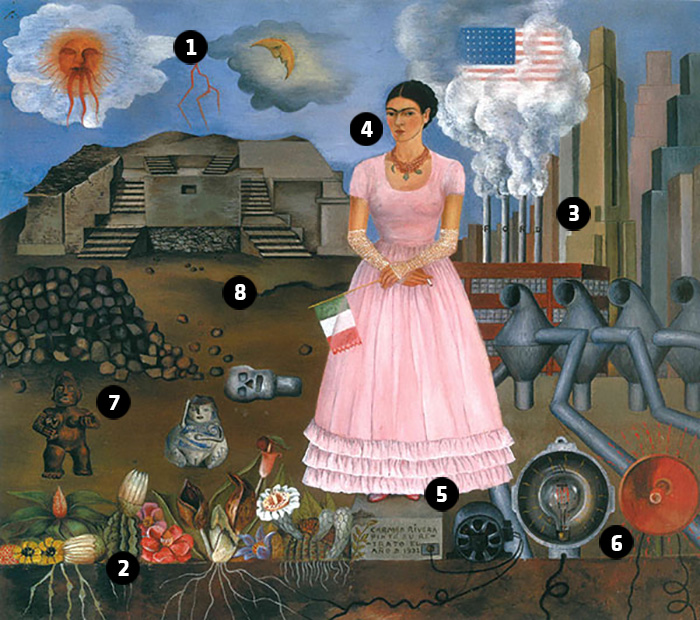
Self-portrait on the borderline between Mexico and the United States (1932)
1) DUALITY. Through her photographs and self-portraits, she created a character that melted with her persona, thus she maintained a relentless seach for her personal identity. “Kahlo cultivated and promoted a public ambiguity that stemmed from her own personal work. By turning her public image into a portrayal, she transformed her paintings into actual mirror of her imaginary prowess… Frida is not a real person but an artistic discourse -a thematic leitmotif- on the level of speech, image, and public representation”.
2) MEXICO. The flower roots represent not only the cultural and family ties that link Frida with her homeland, but they also symbolize the relationship that Mexico holds with the United States, as they feed the American electric generator with their energy. The Mexican side represents the steady and natural cycle of life and death, while the American side represents a lifeless landscape, inflicted byt the overpowering technological advances. “It clearly reflects the interest that Frida nurtered over the course of her tormented life: her art and political struggle, her images of Indians and Mexico’s pre-Hispanic past. All of those amassed with Frida’s burning passion for Mexico and everything mexican”.
3) POLITICS. Frida belonged to a wide and heterogeneous social circle, which allowed her to travel and see different places, reasserting her political and social conviction. “The diversity sensed in their social relationships points at the fact that their ideological choices were result of genuine personal convitcion rather than a symtopm of resentment or alienation”.
3) IDENTITY. Both in pictures and in paintings. Frida always posed staring directly into the front, in a challenging and haughty attitude, showing the same strenght that was escaping from her body and that made up an important element of her identity. ” The picture does not represent the person as it is but as it should, wants or wish to appear”.
4) THERAPY. The gown and the name in the platform are different from what she used to wear and use (Carmen is her baptized name and Rivera her married name), implying that she represented herself acoording to the social conventions to which she oppposed. “Frida describes the mood crudely and somewhat ironically. She hints at the strategy she would often resort in order to face pain -either her own or other people’s-: it is as if by bluntly naming, writing or painting things the artist would be able to chase away the apin, or at least make it more tolerable”.
5) PHOTOGRAPHY. “Photography was one of the most decisive influences in Frida Kahlo’s work. It was because she was always in touch with pictures through her father occupation -Guillermo Kahlo-, and later on, because of her relationship with photographic artists whom she befriended.”
6) INDIGENOUS HERITAGE. For Frida, her indigenous heritage (on her mother side) was source of pride, so she expressed it in her lifestyle, clothing and in her work. “Her Indian heritage was a source of great pride and self-confidence”.
7) PAINTINGS. Many of the photographs in the collection served as models for the pictorical work of Frida and Diego. “Frida reproduced in her paintings some of the images that were especially shocking or moving for her…[She] even used photographic fragments in some of her paintings”.
All qoutes were taken from:
Pablo Ortiz Monasterio (coord.) 2010. Frida Kahlo, sus fotos. Mexico: RM Editions.

